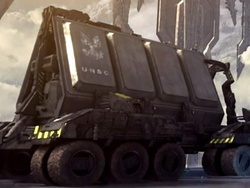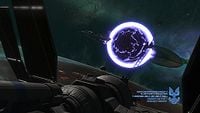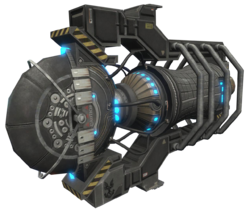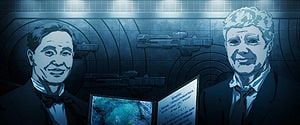Shaw-Fujikawa Translight Engine: Difference between revisions
From Halopedia, the Halo wiki
No edit summary |
m (→History) |
||
| Line 10: | Line 10: | ||
The engine was developed by a group of engineers and theoretical physicists led by [[Tobias Fleming Shaw]] and [[Wallace Fujikawa]] and was completed in April [[2291]].<ref name="Orbital"/> From that point onward, the drive became one of the most important technological innovations of humanity.<ref name="Contact">'''[[Halo: Contact Harvest]]''', ''page 24''</ref> The drive is not without limitations, however, although these may be partially because of slipstream physics rather than engineering imperfections. Short slips may take several months, while longer slips may take over half a year.<ref name="Contact"/> | The engine was developed by a group of engineers and theoretical physicists led by [[Tobias Fleming Shaw]] and [[Wallace Fujikawa]] and was completed in April [[2291]].<ref name="Orbital"/> From that point onward, the drive became one of the most important technological innovations of humanity.<ref name="Contact">'''[[Halo: Contact Harvest]]''', ''page 24''</ref> The drive is not without limitations, however, although these may be partially because of slipstream physics rather than engineering imperfections. Short slips may take several months, while longer slips may take over half a year.<ref name="Contact"/> | ||
By [[2552]], a vast majority of large human spacecraft were equipped with a slipspace engine, including most, if not all | By [[2552]], a vast majority of large human spacecraft were equipped with a slipspace engine, including most, if not all [[UNSC Navy]] warships. | ||
{{clear}} | {{clear}} | ||
Revision as of 16:13, August 9, 2011
- "They have opened a path to the stars for all of us."
- — Dedication to Tobias Fleming Shaw, ScD, QeD, FRS (January 30, 2220 - November 10, 2317), and Wallace Fujikawa ScD, QEnD (April 20, 2215 - February 18, 2318)[1]
The Shaw-Fujikawa Translight Engine (SFTE), colloquially known as the slipspace drive and FTL drive, is a human spacecraft propulsion system capable of making transitions to and from slipstream space and by extension allowing faster-than-light interstellar travel.
History
The engine was developed by a group of engineers and theoretical physicists led by Tobias Fleming Shaw and Wallace Fujikawa and was completed in April 2291.[1] From that point onward, the drive became one of the most important technological innovations of humanity.[2] The drive is not without limitations, however, although these may be partially because of slipstream physics rather than engineering imperfections. Short slips may take several months, while longer slips may take over half a year.[2]
By 2552, a vast majority of large human spacecraft were equipped with a slipspace engine, including most, if not all UNSC Navy warships.
Functionality

The Shaw-Fujikawa Translight Engine functions by creating ruptures, referred to in some sources as wormholes, between normal space and an alternate plane known as slipspace (also known as slipstream space and Shaw-Fujikawa space[3]). The nonstandard physics of slipspace allow it to be used as a shortcut realm, facilitating interstellar travel between distant regions in reasonable time. As astrogation, the coordination of slipspace jumps, cannot be successfully done by a human, the calculations involved in a jump are done by a navigation computer or an AI.[4]
The engine creates ruptures by using high-power cyclic particle accelerators to generate microscopic black holes. Because of their low mass, Hawking radiation gives them a lifetime of around a nanosecond (or potentially a little longer than a whole second)[5] before they evaporate into useless thermal energy. In that nanosecond, the engine manipulates them into forming a coherent rupture between normal space and the slipstream.[6] It should be noted that in real-world physics, black holes have been identified as a possible vector for constructing traversable wormholes, specifically through the use of the Kerr metric.
A slipspace drive does not actually "accelerate" a spacecraft through slipstream space; this is performed by the ship's conventional reaction thrusters. Thus, ships with more powerful conventional engines are also faster within the slipstream.[7] When active, a Shaw-Fujikawa engine emits alpha (helium nuclei) and beta (fast electrons) particles.[8]
Human slipspace drives were considered black boxes[6] which were very difficult to repair or maintain after they went hot for the first time. Spartan-051 considered slipspace drives dangerous[6], noting the aforementioned radiation and that spacetime was said to distort around an active device. Dr. Halsey also observed that in the past, several technicians had simply vanished while manually adjusting a drive.[8] A ruptured slipspace drive can create slipspace "splinters" in normal space, eventually consuming the drive and the entire ship which the drive was placed on.[9] Mechanical failures like Slip Termination, Preventable, or STP, can also occur with Slipspace drives, usually resulting from poor maintenance.[2] An improperly mounted Slipspace drive can also result in catastrophic accidents. This was the case with a colony ship en route to the Cygnus system around 2550: as a result of a maintenance failure, the drive transported half the ship into oblivion.[10]
Although two human ships utilizing the Shaw-Fujikawa engine are suspected of having successfully executed an in-atmosphere slipspace transition, this has not been irrefutably confirmed.[11][12]
The elements Selenium and Technetium are used to manufacture Shaw-Fujikawa Translight Engines. In the 2490's, the colony of Levosia was suspected of diverting the said elements to the black market. The ensuing UNSC blockade of the system and the Insurrectionist reaction eventually led to the Callisto Incident, which is said to have effectively sparked the Insurrection.[13]
Atypical uses

There have been several occasions where a Shaw-Fujikawa Translight Engine has been used for purposes other than those intended.
The UNSC has twice attempted to execute under-powered slipspace transitions. They were both unsuccessful, leading to the conversion of the trial spacecraft into “atomized bits”.[14] In rare cases, the UNSC has used specialized slipspace drives known as "saddle boxes" for military experiments with the slipstream.[15] In 2547, Dr. Catherine Halsey used the slipspace drive of the UNSC frigate Tripping Light to conduct an experiment on building an abstract fractal within slipspace for AI housing.[16][17]
In 2531, the Spirit of Fire reused the nuclear reactor from its slipspace engine as an improvised bomb, in order to induce a supernova in the miniature star at the heart of Shield 0459. Sergeant John Forge was forced to stay behind and detonate it manually due to damage to it and the improvised bomb worked perfectly, destroying the Shield World after Spirit of Fire escaped.[18][19] In the same year, the Office of Naval Intelligence used a partially deconstructed drive to cause Kurt-051's thruster pack to malfunction and send him flying into space so he could be secretly rescued and recruited for the SPARTAN-III project.[6]
During the Fall of Reach in 2552, remembering an accident involving an improperly-mounted Slipspace drive, Catherine-B320 of SPARTAN Noble Team devised a plan to use the UNSC Savannah's Slipspace drive as an improvised "bomb" to destroy the Covenant supercarrier Long Night of Solace, in lieu of nuclear weaponry, which was unavailable at the time. The bomb was transported by a Pelican into the hanger bay of the Covenant corvette Ardent Prayer, which was then hijacked and set on a refueling track with the supercarrier. The activation timer for the "bomb" was damaged in a firefight, so Jorge-052 stayed behind to activate it manually, while SPARTAN-B312 was forced out of the ship. When the Slipspace drive was activated, a massive Slipspace rupture was created, which caused Ardent Prayer, along with a large portion of Long Night of Solace, to be teleported into oblivion. With its entire midsection missing, the remains of Long Night of Solace crashed onto the surface of the planet Reach.[10]
Terminology
The term for making a transition between normal space and the slipstream is "jump" or "slip". Halo Wars introduces additional terminology for the slipspace drive. It is referred to as an FTL (for "Faster Than Light") drive and FTL reactor several times, and the process of initializing it for a slip was referred to as “spinning up”. This may be an attempt to introduce more accessible nomenclature for newcomers to the Halo franchise, and is likely to be a reference to the TV show Battlestar Galactica as they also refer to preparation for use of an FTL drive as "spinning up". Another explanation is that the drive most likely requires time to power up the particle accelerators and reach the mini-black-hole-creating threshold. The accelerators are most likely circular, and the subatomic particles could be said to "spin" around the center of the accelerator. The term "FTL drive" is also used in the story The Impossible Life and the Possible Death of Preston J. Cole in Halo: Evolutions.
List of appearances
Sources
- ^ a b Halo 3, multiplayer level Orbital
- ^ a b c Halo: Contact Harvest, page 24
- ^ Halo: The Fall of Reach, page 141
- ^ Halo: Contact Harvest, page 96
- ^ FoxNews: Scientists Not So Sure 'Doomsday Machine' Won't Destroy World
- ^ a b c d Halo: Ghosts of Onyx, page 53 (Fred-104: "They had to repair the [drive] on the Magellan. It was a risky op. Those things aren’t meant to be taken apart once they go active.")
- ^ Halo: Contact Harvest, page 23
- ^ a b Halo: Ghost of Onyx, pages 145-146
- ^ Halo: Evolutions - Essential Tales of the Halo Universe - The Mona Lisa, page ??
- ^ a b Halo: Reach, campaign level Long Night of Solace
- ^ Halo: Evolutions - Essential Tales of the Halo Universe - The Impossible Life and the Possible Death of Preston J. Cole, page 474
- ^ Halo: Evolutions - Essential Tales of the Halo Universe - The Impossible Life and the Possible Death of Preston J. Cole, pages 484-485
- ^ Halo: Evolutions - Essential Tales of the Halo Universe, The Impossible Life and the Possible Death of Preston J. Cole, page 436
- ^ Halo: Ghosts of Onyx, page 225
- ^ Halo: First Strike (2010), Tug o' War
- ^ Dr. Halsey's personal journal, September 4, 2547
- ^ Halo: Reach, Data pad 17
- ^ Halo Wars, campaign level Reactor
- ^ Halo Wars, campaign level Escape

